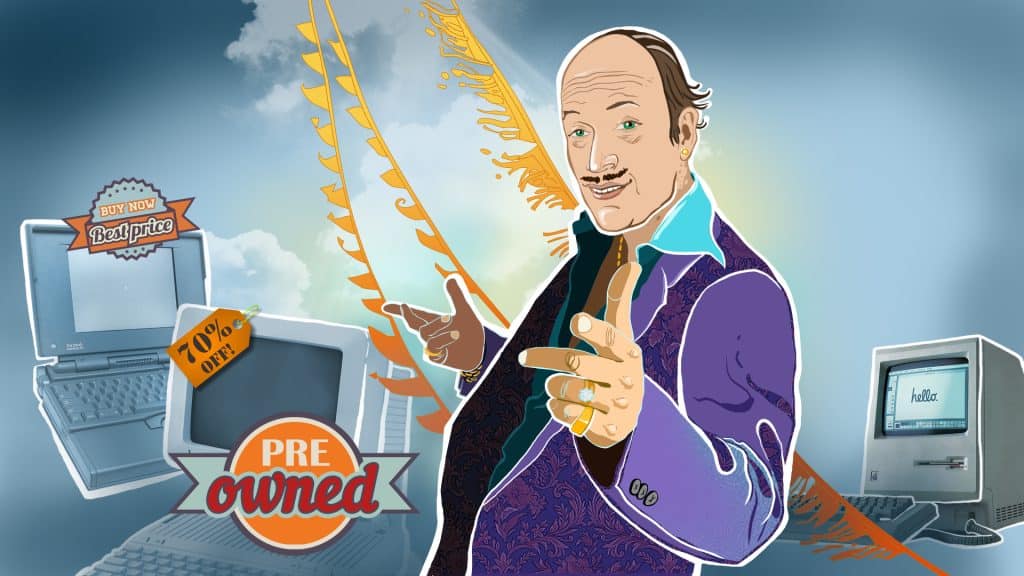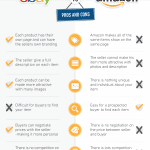
For many ecommerce retailers, the thought of selling used products seems like an act of desperation. Often, selling used goods is seen as a reputation killer that reduces a business to the same category as the slimy used car salesman or the turn-of-the-century grifter selling exotic potions out of a wagon—a business willing to go to extremes to make a buck.
This is enough to keep most sellers out of the used merchandise space altogether. You can see the logic. Why sell opened, previously owned merchandise when you can sell brand-new, factory-sealed products? Why risk allowing negative reviews from used product transactions to affect your sales of new products?
While selling used goods certainly comes with challenges, it represents a new reality of what it takes to grow your ecommerce business. As online marketplaces make it easier and easier for customers to return products to sellers (with or without cause), sellers face a swelling pile of returned inventory that has value but can no longer be sold as new. Often, this inventory is never resold at all.
Thankfully, there are still ways to transform that inventory from a loss into a profit. What’s more, the Descartes Sellercloud inventory management system can help. This isn’t Rumpelstiltskin trying to spin straw into gold or the eccentric alchemist trying to magically transform lead bars—this is smart business.
Eliminate the Unsellable Inventory Pile
Take a look at your inventory data. If you are like most ecommerce retailers, you are seeing higher percentages of returned sales than you did in years past. A large contributor to this trend is the growing empowerment and entitlement of the average online customer. Everyone from Amazon to eBay, Walmart to Newegg has added simplified return policies that enable customers to easily return items to sellers for refunds, and customers are taking advantage.
In the long term, these policies boost consumer confidence and convenience, continuing to steer more buyers toward online retail and away from brick-and-mortar stores. In the short term, these policies cause plenty of headaches for online sellers.
One of the major problems with this type of consumer behavior is that sellers are left to figure out what to do with increasing quantities of returned inventory. Even if these products are in perfect condition, this merchandise can no longer be advertised and sold as new according to most state and federal laws and most online marketplace policies.
Just Because Your Business Sells Refurbished Items Doesn’t Make It a Used Product Business
Once upon a time, sales were final, and returns were prohibitively difficult for consumers. That fairy tale is over. Even eBay, known for making it easy to sell used goods, now requires every item on its platform to have a standard return option. Nowadays, you must be prepared that any items you sell might find their way back to you. Once they do, no magic wand can transform those returned products into factory-sealed, brand-new inventory.
That leaves two options: discard what is likely perfectly good merchandise and eat the loss, or sell the inventory as used products at a discount and salvage a profit. Neither is ideal, but most business people would probably agree that the latter clearly outweighs the former.
If you are serious about maximizing your retail profits in today’s ecommerce environment, you need a plan for reselling returned inventory. That means developing a system to bring returned merchandise up to the standards of today’s picky consumers and strict marketplaces.
Descartes Sellercloud can help. Our tools enable sellers to navigate the return merchandise authorization (RMA) processes of the leading online marketplaces, account for returned inventory, and track products as they go through the necessary steps to become reconditioned and refurbished for sale.
It starts with an RMA shipping label. Descartes Sellercloud makes it easy to turn a customer’s return into a seamless part of your inventory flow that is both trackable and reliable. As an added protection against loss, these RMA claims can issue return shipping labels to customers that are pay-on-use.
This ensures that you are not charged for return shipping costs unless the label you send to the customer is actually scanned by the shipping company. Once the returned package arrives at the warehouse, the label’s RMA barcode can be scanned and signal to warehouse employees that the item needs to be placed in a quarantine where it will not mistakenly wind up back in the sellable inventory channel.
This allows the seller to inspect the inventory before deciding how to process the product for eventual resale. Similarly, returns from Fulfilment by Amazon (FBA) orders can be ‘removed’ from the Amazon warehouse and easily transitioned back into inventory if they are in perfect condition.
However, this depends on Amazon’s warehouse staff to judge the state of each returned item. If there is any question as to an item’s quality, you can expect Amazon to err on the side of caution and flag an item as not sellable when, in fact, you might deem it worthy of being placed back into your available inventory.
Alternatively, Descartes Sellercloud also allows sellers to create credit memos for sending a returned product back to the manufacturer or vendor for a refund. Sellers can use serial number tracking features to trace the returned item back to the original purchase order and identify the appropriate vendor to contact.
Take Advantage of Marketplace Certified Refurbished Programs
‘Used’ sounds like a dirty word. Label something as used, and it conjures up the notion that it is unclean or has long since outlived its optimal usefulness. If given the choice of a new car or a used car, which would you opt for? What if, instead of a car, it was a pillow? How about earbuds? See what I mean?
Fortunately, most retailers have adopted language that helps sellers circumvent the negative connotation of the word used when it comes to marketing their like-new inventory. Every ecommerce marketplace has its own terminology for high-quality used merchandise.
Amazon offers Amazon Renewed products. Walmart features Certified Refurbished Electronics. eBay dedicates an entire webpage to Certified Pre-Owned items. Whatever the marketing jargon of choice may be, these programs all essentially serve the same purpose: they scrutinize used merchandise with a set of standards designed to promote customer confidence.
As a result, items labeled ‘renewed,’ ‘refreshed,’ or ‘certified pre-owned’ are expected to perform like their new counterparts. The products and their accessories are all accounted for and are either in new or like-new condition. Ultimately, these programs make it easier to transform returned items into sellable, profitable inventory.
For products that have received more use than just an opened package, there are refurbishing options that can bring the item into compliance with the rigorous standards of certified refurbished programs:
- ‘Manufacturer-refurbished’ products are repaired, cleaned, and inspected by the manufacturer or one of its vendors to ensure they are in perfect working condition. These products are often sold with warranty policies identical to or very similar to those of new items.
- ‘Seller refurbished’ products are repaired, cleaned, and inspected by someone other than the manufacturer or one of its vendors. The seller attests that each product has been repaired, cleaned, and inspected to ensure it is in perfect working condition. The seller may offer a warranty to bolster consumer confidence further.
- Ecommerce sites often mandate additional guarantees for refurbished products to signify faith that the products will hold up to consumer scrutiny.
- For instance, Walmart and Amazon each require a minimum 90-day seller-backed warranty for these types of ‘renewed’ items.
Refurbishing has become particularly popular in the consumer electronics market. Customers can get their hands on expensive devices like smartphones, televisions, gaming systems, tablets, and PCs at steep discounts if they are willing to settle for refurbished instead of brand-new ones. In many cases, the only things separating these items from their brand-new counterparts are minor cosmetic nicks or broken warranty seals.
One of the leaders in this arena is Back Market, the largest reseller of refurbished products in Europe and a fast-growing newcomer in the American consumer space. Back Market’s business model centers on reducing e-waste (6,300,000 tons produced in 2018 in the US alone) by refurbishing and reselling used consumer electronics at affordable prices and with a generous 6-month warranty.
Descartes Sellercloud has recently integrated with Back Market due to the growing interest from our clients.
Protect Your Brand by Keeping Your New and Refurbished Sales Separate
One of the main excuses sellers lean on to justify leaving returned inventory to sit unsold is the fear of negative feedback. After all, customers who were unsatisfied (for whatever reason) had already returned the items once. Why risk it happening again? It’s true. There is naturally a higher rate of complaints for used and refurbished items.
Similarly, negative feedback jeopardizes your selling power as a third-party retailer online. Amazon, for one, has a notoriously low tolerance for third-party sellers that accumulate even modest volumes of customer complaints. As such, there is an obvious risk associated with marketing products to buyers whose expectations might be out of line with the reality of what they are purchasing.
There are plenty of shoppers who will presume they are receiving perfectly new products, regardless of how clear your descriptions of any imperfections may be. Making matters worse, most marketplaces will allow disappointed customers to return the item and leave negative feedback regardless of whether they are in the right or not.
Chin up. Selling refurbished items is and will increasingly become an essential piece of successful online ecommerce. Getting in on the game now may be challenging and frustrating, but it is a necessary step. That said, you should be proactive in handling the used product portion of your business so that you are prepared for the occasional prickly buyers and confident they won’t tarnish your established reputation.
The important thing to remember is that just because your business sells refurbished items doesn’t make it a used product business. The ability to transform unsellable inventory into profitable sales will mitigate losses and allow your sales of new products to thrive. Before listing a single refurbished item, investigate the terms and options available to you on your preferred ecommerce marketplaces.
The ideal option is to create multiple seller accounts on these platforms, keeping your new inventory on one account and marketing your refurbished inventory on another. Some sites, like eBay, allow one seller to have multiple eBay stores that are associated with each other. Other marketplaces, like Amazon, generally don’t allow having multiple accounts, but we have seen them allow it in circumstances like this with special permission.
Whether it is easier or harder, putting in the legwork upfront to delineate between your new and used inventory will pay off in the end. One important thing to remember is to never list the same item with the same condition on both selling profiles.
Descartes Sellercloud can configure inventory rules, which we call a custom inventory calculation, to help make sure that you are compliant with these types of requirements. Once your accounts are established, Descartes Sellercloud can handle things from there. Our inventory management system is equipped to handle multiple seller profiles within the same marketplace.
Descartes Sellercloud can also flag your inventory designated for refurbished sales programs so that it can be processed differently than your orders for new products. Combine those features with a reliable RMA tracking system, 350+ integrations, and reliable customer support, and you have a dependable partner ready to maximize the profitability of your entire inventory—new, refurbished, refreshed, or renewed.
Selling refurbished inventory may not be a fairy tale, but it doesn’t have to make you the snake oil salesman performing on the town square, either.
Schedule a live demo to see how Descartes Sellercloud can help you establish and manage your reputable position in the used products space.




